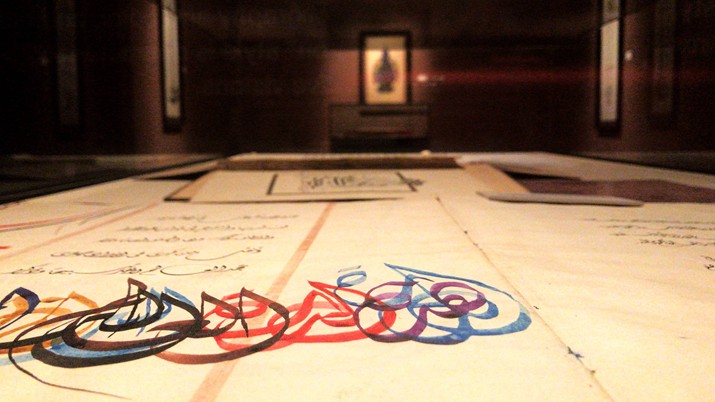
15 Jan, 2018

By Salma Alalem
The Fourth Dimension Exhibition opened on Jan.10 at the Sharjah Calligraphy Museum to shed light on a pioneering calligraphy experience through the select artworks of the late Sudanese artist, Osman Waqialla.
The exhibition, considered the first solo exhibition for the late Waqialla in MENA, was organised by the Sharjah Art Foundation under the 20th edition of the Sharjah Islamic Arts Festival (SIAF), which is themed “Impact” and organised by the Cultural Affairs Department at the Sharjah Department of Culture.
The opening of the exhibition was attended by Abdullah Mohammed Al Owais, Head of SIAF Higher Committee, Mohammed Al Murr, an Emirati writer and owner of the biggest calligraphy collection in the UAE, Hana Osman, daughter of the late artist Osman Waqialla, and Taj Al Ser Hasan, the coordinator of the exhibition and one of Waqialla’s students and friends.
The artist’s daughter, Hana, told The Gulf Today, “I was very close to my father, and I wanted to keep his art alive. Although he had many exhibitions in Sudan and other countries including Canterbury Art Institute, the University of Oxford, the Islamic Cultural Centre in London, the National Museum of Damascus, the City of Birmingham College, the Westminster Gallery in London, the Gallerie Valle Meperes in France, and the Conquer Barbican Gallery.”
“However, this exhibition is considered the first solo exhibition for him after his death. It is being held in line with his tenth death anniversary which was on Jan.4, 2007,” she added.
Waqialla was part of an active and culturally prosperous visual art movement in the Arab world. He is regarded as an influential figure and a source of inspiration for many generations of Sudanese artists.
Moreover, the exhibition refocuses attention on the works of Waqialla and paves the way for a contemporary aesthetic reading and re-exploration of his pioneering artworks.
She mentioned that most of his artworks were achieved during Ramadan, as he would enjoy drawing all night then offer Fajr prayers and sleep. He was keen on creating his own painting tools from some plants of the environment such as sugarcane.
Commenting on some of Waqialla’s old photos, Hana mentioned, “My father was very humble and modest although he was internationally renowned; he would wear normal, simple clothes of Sudanese without any kind of sophistication.”
The exhibition showcased various types of calligraphy artwork including ink on paper and ink on papyrus for poems, Quran verses, some books that he wrote, and other masterpieces that were awarded in Egypt, UK, and France.
In his unique handwriting, he completed the Quran and a large number of Quranic paintings. He was a founding professor at the College of Fine and Applied Arts in Khartoum 1951, a founding member of both the Sudanese Writers Association and the Union of Sudanese Fine Arts.
Taj Al Ser mentioned that he met him for the first time in 1982, when he went to London to study for his master’s degree in graphic design. Waqialla studied in England, at the Camberwell School of Art in 1946, in the City of Coral Gables Art and in Corto for the history of arts in London. He moved to England in 1967 and lived there until 2005.
“I am glad to be the coordinator of such an exhibition for a great model in the calligraphy art of the Middle East, especially that the late Waqialla was the first calligrapher who took into consideration the importance of Arabic School in Calligraphy as the Sudan environment is affected more by African style than the Arabic type,” he indicated.
The SIAF, which will conclude on Jan.23, has showcased various types of Islamic art in several venues in Sharjah, including: Sharjah Art Museum, Maraya Art Centre, Calligraphy Square, Al Majaz Waterfront, Al Majaz Amphitheatre, and Sharjah Calligraphy Museum.

© 2024 Copyright Department of Culture